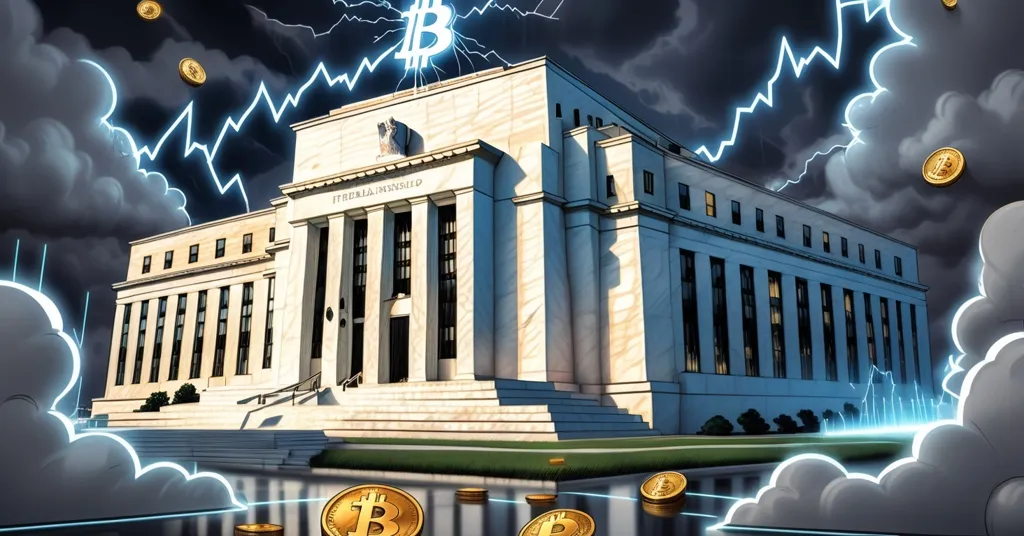Fed’s Waller Backs 25bps Rate Cut: Bitcoin and Crypto Markets Brace for Impact

Fed’s Waller Endorses 25bps Rate Cut: Bitcoin and Crypto Markets on Edge
Federal Reserve Governor Chris Waller has signaled support for a modest 25 basis point (bps) interest rate cut at the upcoming Federal Open Market Committee (FOMC) meeting on October 28-29, citing a weakening labor market as a pressing concern. But the Fed isn’t a monolith—Governor Stephen Miran is pushing for a bolder 50 bps slash, warning of deeper economic cracks and geopolitical headwinds. With Bitcoin and cryptocurrency markets sensitive to monetary policy shifts, the outcome of this debate could either fuel a rally or pour cold water on risk assets.
- Waller’s Caution: Backs a 25 bps cut, wary of inflation but open to more if the economy worsens.
- Miran’s Urgency: Advocates a 50 bps cut, projecting 75 bps total reductions this year amid broader risks.
- Data Blindspot: Government shutdown stalls key economic stats, leaving the Fed guessing.
Waller’s Measured Approach to Monetary Policy
Waller, speaking at the Council on Foreign Relations, laid out a pragmatic stance on easing monetary policy—essentially, lowering interest rates to spur economic activity. For those new to the jargon, a basis point is one-hundredth of a percentage point, so a 25 bps cut translates to a 0.25% reduction in rates. His primary worry is the labor market, where recent data shows softening—think slower job growth or rising unemployment—that could signal a broader slowdown.
“Based on all of the data we have on the labor market, I believe the FOMC should reduce the policy rate another 25 basis points at our meeting that concludes Oct. 29. But beyond that point, I will be looking for how the solid GDP data reconcile with the softening labor market,”
Waller said in a recent discussion on the Fed’s upcoming rate cut decision. He’s playing it safe, keeping a close watch on how strong GDP numbers square with these labor market red flags. His bigger fear? Moving too fast and reigniting inflation, undoing years of progress.
“What I would want to avoid is rekindling inflationary pressure by moving too quickly and squandering the significant progress we have made taming inflation. The labor market has been sending some clear warnings lately, and we should be ready to act if those warnings are validated by what we learn in the coming weeks and months,”
he added. For Bitcoin hodlers, this cautious 25 bps cut might mean a stable dollar in the short term, potentially delaying BTC’s next big run as an inflation hedge. But if labor data worsens and Waller pivots to deeper cuts, that could flip the script, pushing investors toward decentralized assets.
Miran’s Lone Wolf Call for Aggressive Action
Contrast that with Stephen Miran, who’s been barking up a storm for a more aggressive approach. In a Fox Business interview, he argued for an immediate 50 bps cut, with a total of 75 bps—three 25 bps reductions—by year-end.
“My view is that it should be 50 basis points. However, I expect it to be an additional 25 and I think that we’re probably set up for three 25-basis-point cuts this year, for a total of 75 basis points this year,”
Miran stated. His urgency isn’t just about jobs—it’s fueled by geopolitical risks, notably rising U.S.-China tensions that could ripple through global markets via supply chain disruptions or currency skirmishes. This isn’t Miran’s first rodeo; he was outvoted 11-1 in September for a 50 bps cut, showing just how divided the FOMC is on the pace of easing. The guy’s basically the Fed’s resident doomsayer, but is the rest of the committee too cozy with Wall Street to heed his warnings?
For crypto markets, Miran’s stance could be a shot of adrenaline. Bigger rate cuts often mean cheaper borrowing, driving speculative cash into risk-on assets like Bitcoin and altcoins. But here’s the kicker—his push for aggressive action also signals fear of a deeper economic rut, which could spook investors into safer havens, crushing crypto in a risk-off wave. It’s a coin toss, and Bitcoin’s volatility might just remind us why we’re betting on decentralization in the first place.
Data Blackout: Fed Flying Blind
Complicating this whole mess is a government shutdown that’s delayed critical economic indicators—unemployment rates, consumer spending, you name it. Without these numbers, the Fed’s navigating a storm with a broken compass. Miran didn’t hold back on the frustration this causes.
“It would be really helpful to have the economic data in order to be able to make the decisions we need to make. Without those data, we still have to make a decision anyway, and so we’ll have to rely upon our forecasts for doing so,”
he noted. Let’s break this down for newcomers: the Fed relies on hard data to gauge the economy’s health. No data means they’re stuck with guesses—forecasts that could be way off. A misstep here might overstimulate the economy with too-big cuts, spiking inflation, or undershoot with too little, deepening a slowdown. Either way, the uncertainty could jolt traditional and crypto markets alike. And frankly, this clown show of centralized guesswork is exactly why Bitcoin’s transparent, trustless ledger looks more appealing by the day.
Inflation, Tariffs, and Powell’s Take
Inflation remains the Fed’s boogeyman, and President Donald Trump’s tariffs aren’t helping. These taxes on imported goods often jack up consumer prices in the short term, adding to price pressures. Waller, though, sees them as a temporary blip, not a long-term inflation driver, aligning with most of the FOMC’s preference for gradual cuts over Miran’s slash-and-burn tactics. Fed Chair Jerome Powell has also weighed in, pointing to slowing hiring as a reason to keep rate cuts on the table. Meanwhile, September FOMC projections suggest two more cuts in 2025, though Miran’s gunning for a hefty 1.25 percentage point drop by next year’s end.
Here’s a devil’s advocate thought: what if Waller’s caution is spot-on, and Miran’s aggressive cuts overheat the economy? Picture a scenario where too much cheap money floods the system, inflation roars back, and the Fed has to slam on the brakes with rate hikes. That could tank both fiat and crypto markets, as liquidity dries up and risk assets get slaughtered. It’s not just about stimulating growth—it’s about not breaking the damn engine.
Bitcoin and Crypto Caught in the Crossfire
Let’s cut to the chase: Fed policy ripples straight into Bitcoin and cryptocurrency markets. Historically, rate cuts have been rocket fuel for risk assets. Look at 2020—when the Fed slashed rates to near-zero during the COVID-19 crisis, Bitcoin surged from under $10,000 to nearly $69,000 by late 2021, partly as investors sought alternatives to a weakening dollar. Lower rates mean cheaper borrowing, often pushing capital into speculative plays like BTC and altcoins.
But don’t pop the champagne just yet. Today’s backdrop is messier—stubborn inflation and labor market jitters could flip the script. If Miran’s fears of a deeper slowdown materialize, investors might ditch risk assets altogether, even with rate cuts, sending Bitcoin and especially altcoins into a tailspin. BTC might still shine as a store of value, a hedge against a crumbling economy, but altcoins like Ethereum—tied to speculative DeFi and NFT narratives—could get obliterated in a risk-off mood. Ethereum’s DeFi ecosystem might see a temporary boost from cheaper borrowing for yield farming, but let’s be real: unsustainable hype and rug pulls are always lurking in that space.
Geopolitical wildcards add another layer of chaos. U.S.-China tensions, as Miran flagged, could disrupt global trade or spark currency wars. Bitcoin could benefit as a neutral, borderless asset—think of it as digital gold in a fractured world. But if global markets tank, even BTC might not escape the carnage of a broader sell-off. And a quick heads-up to our readers: don’t fall for shills on social media hyping rate cuts as a guaranteed moonshot. Crypto’s volatile as hell, and macro risks are real. We’re here for no-BS reporting, not pump-and-dump fantasies.
Centralized Chaos vs. Decentralized Promise
Stepping back, the Fed’s fumbling in this data blackout is a glaring reminder of centralized systems’ flaws. They’re guessing while markets hang in the balance, wielding power over money supply that can make or break economies—and your portfolio. This is exactly the kind of opacity and inefficiency Bitcoin was built to dismantle. A trustless, transparent ledger doesn’t rely on a handful of suits in a boardroom making calls without data. If the Fed botches this, it’s just more fuel for Bitcoin’s fire. Let’s fast-track a world where central bankers don’t call the shots—effective accelerationism in action.
That said, we’re not blind to the other side. Bitcoin isn’t immune to macro storms. If Waller’s gradualism keeps the economy steady, BTC might not get the dollar-weakness boost maximalists crave. If Miran’s dire warnings come true and aggressive cuts fail to prevent a recession, even Bitcoin could bleed as panic sets in. Altcoins, often more speculative, face even steeper risks—think of them as the wildcards in a deck stacked with uncertainty.
Key Questions and Takeaways for Crypto Enthusiasts
- How do Federal Reserve rate cuts impact Bitcoin prices?
Rate cuts often lower borrowing costs, funneling money into risk assets like Bitcoin. Past cuts, like in 2020, fueled BTC’s rise, but current inflation and economic fears could dampen or reverse such gains if risk aversion kicks in. - What’s the split among Fed officials on interest rate policy?
Chris Waller supports a cautious 25 bps cut at the October 28-29 FOMC meeting, fearing inflation, while Stephen Miran urges a 50 bps cut, targeting 75 bps total this year due to economic and geopolitical risks. - Why does a government shutdown complicate Fed decisions for crypto markets?
It delays vital data like unemployment stats, forcing the Fed to rely on shaky forecasts. Missteps could spike volatility across markets, including Bitcoin and altcoins, as uncertainty rattles investors. - Can geopolitical tensions like U.S.-China disputes affect cryptocurrency?
Yes, tensions could disrupt trade or spark currency conflicts, potentially boosting Bitcoin as a safe haven or dragging down all risk assets if global markets sour. - Should crypto investors worry about inflation from Trump’s tariffs?
Waller sees tariffs as a short-term price spike, not a lasting inflation threat, so the Fed may avoid drastic moves. This could stabilize sentiment, though crypto markets might still react to broader policy noise. - Are altcoins more vulnerable than Bitcoin to Fed policy shifts?
Definitely—altcoins like Ethereum thrive on speculative waves from cheap money but crash harder in downturns. DeFi might see short-term activity, but hype and scams often follow.
The Fed’s October decision is a high-stakes game, and its ripples will hit far beyond Wall Street. Waller’s cautious 25 bps cut might keep things on an even keel, but Miran’s push for deeper action hints at cracks in the economic foundation. Toss in a data blackout and geopolitical curveballs, and you’ve got a perfect storm of uncertainty. For Bitcoin and crypto enthusiasts, the takeaway is simple: stay sharp. This isn’t just about interest rates—it’s about the signals they send to every corner of finance, decentralized or otherwise. If the Fed stumbles, Bitcoin’s volatility might just underscore why we’re building a system free from centralized meddling. Buckle up, crypto fam—this ride’s about to get bumpy.



